Thermoformed platform
a platform and thermoplastic technology, applied in the field of thermoplastic platforms, can solve the problems of each method characterized, low market share of plastic pallets, and high cost of comparable wooden pallets
- Summary
- Abstract
- Description
- Claims
- Application Information
AI Technical Summary
Problems solved by technology
Method used
Image
Examples
Embodiment Construction
[0049] U.S. patent application Ser. No. 09 / 377,792, in the name of the present inventor, discloses triple sheet thermoforming apparatus, methods and articles, and is incorporated herein, in its entirely, by such reference. It has been determined by the present inventor that threes sheets of plastic can be sequentially thermoformed in a single manufacturing process to provide a unitary article, such as a pallet, having a hybrid honeycomb type structure. The inventor has reduced triple sheet load bearing platforms to practice and has compared the same to several corresponding bench mark twin sheet load bearing platforms in a controlled test environment administered by an independent third party. Triple sheet platforms have a demonstrably superior level of load bearing strength than twin sheet platforms having substantially the equivalent weight or volume of plastic material. Accordingly, three relatively thinner sheets comprising a much lower volume of plastic can be utilized in a tri...
PUM
 Login to View More
Login to View More Abstract
Description
Claims
Application Information
 Login to View More
Login to View More - R&D
- Intellectual Property
- Life Sciences
- Materials
- Tech Scout
- Unparalleled Data Quality
- Higher Quality Content
- 60% Fewer Hallucinations
Browse by: Latest US Patents, China's latest patents, Technical Efficacy Thesaurus, Application Domain, Technology Topic, Popular Technical Reports.
© 2025 PatSnap. All rights reserved.Legal|Privacy policy|Modern Slavery Act Transparency Statement|Sitemap|About US| Contact US: help@patsnap.com



